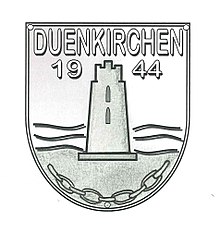Dunkirk shield
The Dunkirk shield was a traditional badge that was awarded during the Second World War .
Background to the creation of this award
In an instruction of September 4, 1944, Adolf Hitler had Dunkirk declared a fortress. The term fortress included the port itself and the city of Dunkirk. As part of the defense of the fortress Dunkirk by the Allied invasion of Normandy took its beginning, was created under the leadership of Vice Admiral Friedrich Frisius soon the idea of a kind of memory shield for the enclosed 12,000 to create up to 15,000 German defenders. The Dunkirk fortress finally surrendered to French, British and Czech units on May 9, 1945. During the siege, Frisius had the so-called Dunkirk shield made from makeshift metal supplies and distributed to the soldiers of the army , navy and probably also to an unknown number of Wehrmacht retinues in order to strengthen their sense of community. The “award” of the shield was confirmed with the entry in the pay book .
Definition of terms
In connection with the “Dünkirchenschild”, people mistakenly speak of a sleeve shield , which had its origins in the Wehrmacht with the foundation of the Narvik shield since the outbreak of World War II . However, this assumption is incorrect. The Dunkirk shield was never intended as a sleeve shield, but was worn on the left side of the field cap , similar to the edelweiss of the mountain troops .
Unofficial award
The Dunkirk shield is not a weapon or combat badge of the Wehrmacht, since - similar to the remote patrol badge - neither its foundation nor the award took place officially. The Dunkirk shield was therefore only seen as a "traditional badge". With the entry in the pay book, there was also no entitlement to official acceptance of the sign by the Federal Ministry of the Interior . Therefore, this shield has not been included in the Law on Titles, Medals and Decorations of July 26, 1957.
Appearance
The Dunkirk shield was made from remaining metal supplies (sheet iron and non-ferrous metal). Its width is approx. 34 mm and its height is 41 mm. The shape corresponds to the shape of the shield, with the lighthouse of Dunkirk being shown in the middle . The number 19 is stamped on the left and the year 44 next to it (1944). Above the lighthouse you can read in capital letters DUENKIRCHEN . On the lower side of the shield there is an anchor chain and the relief of thrown sea waves.
literature
- Kurt-Gerhard Klietmann : The awards of the German Reich 1936-1945 , 11th edition 2004, pp. 99-100.
